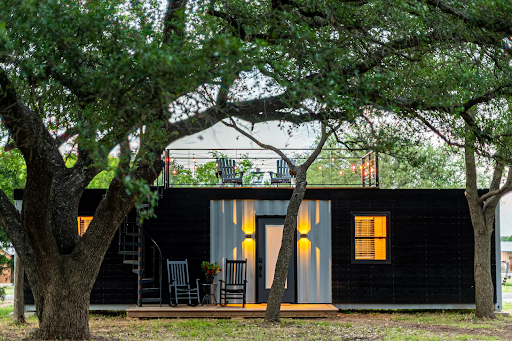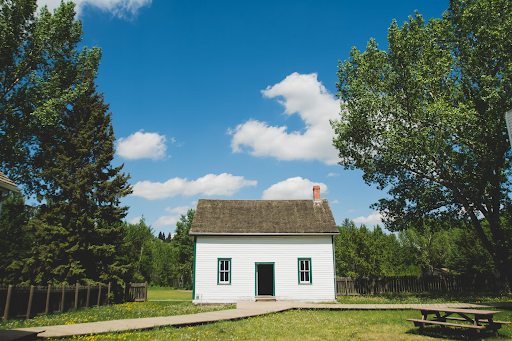By Home Nation Updated February 14th, 2025

Nontraditional homes are becoming more popular than ever as people get more creative on their paths to owning a home.
The alternatives to stick-built homes are growing, and as manufactured and modular homes become more prevalent, kit homes are making their way into the mainstream—you can even buy kit homes online from retailers like Amazon and get everything you need to build your house delivered to your property.
As new and exciting as this sounds, kit homes have actually been around for many years. Here’s what to know before buying into the kit home trend.
Related: What Is a Builder Package?
What Exactly Is a Kit Home?
You can think of kit homes like mail-order houses—like prefab homes—that are delivered in parts by the manufacturer and built on your property by you or a contractor. After delivery, they are built in a similar fashion to traditional homes.
A significant benefit of kit houses is that the costs are far less than hiring a contractor to source the same materials. In addition, you can order hit homes to build almost anything—a bungalow, a studio, a three-bedroom modern home, etc.
While retailers have revived the interest in kit homes, they were quite common in the early 20th century. Over 100,000 kit homes were built in the early 1900s, with Sears being one of the biggest manufacturers during that era.
How Is Kit Home Different From Mobile Homes?
Kit homes and mobile homes serve distinct segments of the housing market, catering to diverse preferences and needs. Kit homes are favored by those seeking cost-effective, customizable solutions, offering homeowners the opportunity to actively engage in the construction process.
With the flexibility to hire professionals or embark on DIY projects, kit homes empower individuals to shape their living spaces according to personal preferences. Conversely, mobile homes, governed by HUD standards, provide an immediate housing option with the added benefit of mobility, enabling relocation if required.
Despite their divergent approaches, both options present unique advantages and considerations, ranging from cost-effectiveness and design flexibility to installation requirements and portability. Therefore, the decision between a kit home and a mobile home hinges on individual circumstances, including budget constraints and desired levels of involvement in the home-building journey.

How Much Do Kit Houses Cost?
While the price of kit homes varies drastically based on layout, location, and size, they are still much more affordable than typical houses of the same style. Most manufacturers of kit houses use a similar business model to those of manufactured and modular homes—and many of them offer modular options for their kit homes where the pieces are built off-site and delivered to your property in sections.
Because these kits are created in climate-controlled environments, the build time is drastically shortened, which also reduces labor costs. In addition, the manufacturers purchase construction materials in bulk for their factories, resulting in significantly lower material costs than if you outsourced the materials for a stick-built home.
When considering kit homes, it's essential to understand the pricing structure. Here are the corresponding total cost ranges for kit homes based on different square footages:
|
Total Square Feet |
Total Square Feet |
|
2,000 sq ft |
$60,000 - $160,000 |
|
3,000 sq ft |
$90,000 - $240,000 |
|
3,500 sq ft |
$105,000 - $280,000 |
A bare-bones kit home can cost as little as $30 per square foot; however, the cheaper kits don’t typically come with any interior elements, drywall, etc. A more typical cost would be anywhere from $40-$80 per square foot, which is still much more affordable than typical stick-built homes.
Before buying a kit home, it’s a great idea to consult with a contractor to get a better estimate about what each kit includes and any additional costs you might have to pay.
How Much Does it Cost to Build a Kit Home?
It’s not difficult to get swept up in the excitement of buying a house online and having it delivered to you with such a low price tag—especially when you’ve been hunting for homes for sale or thinking about building a new one.
Related: The New Affordable Home
And while it’s true that kit homes are typically a much cheaper option compared to stick-built houses, there are plenty of other costs to think about, too.
For example, the actual kit price is only a portion of the total cost. Unless you plan to build it yourself, construction labor costs can cost over $100 per square foot. In addition, remember that you’ll have to furnish cheaper kits with drywall, flooring, etc., which can quickly up your costs.
You’ll also need to consider how much it will cost to buy land and remove obstructions. Plus, if you want running water, electricity, etc.—which you likely will—you’ll have to pay for professionals to set up sewer mains, gas lines, and other utility services.
Before purchasing a kit home, you should always meet with a contractor to determine if it will be worth it for you.
Buying and Building a Kit Home: Pros and Cons
Like any financial decision you have to make, there’s no answer that’s right for everyone. For example, kit homes might not save you much if the area you live in is low-cost already.
Consider these pros and cons of buying and building a kit home before pulling the trigger:
Pros of Buying a Kit Home
The benefits of kit homes include:
-
The cost — Kit homes are usually cheaper than typical stick-build homes for many reasons, including the ones listed above.
-
Fast delivery — When you order a kit home, you can typically get the entire kit delivered to your property in a few weeks.
-
Quick construction — Kit homes come with every piece labeled and pre-cut. They also include easy directions on assembly, making building them quite simple for anyone with basic construction knowledge.
-
Customization — Because you build kit homes from the ground up, customizing them to bring your homeowner’s dream to life is much easier than other options.
-
Quality — High-quality kit homes are as durable as other stick-build houses, they can easily last for many years, and you always get a brand-new home instead of an already lived-in one.
Cons of Buying a Kit Home
Some disadvantages of kit homes include:
-
Delivery limits — Many manufacturers won’t deliver too far from their factories due to transportation costs. So if you want a layout from a far away manufacturer, you’ll pay significant delivery fees for that privilege.
-
Location dependant — In metropolitan areas, kit homes are typically an affordable option. However, if you live in a lower-cost or rural area, kit homes might cost more than building or buying a traditional stick-built home.
-
Regulations — Because the kit home industry is experiencing a new boom, there are no industry standards or HUD regulations. Kit homes might include a foundation and drywall, while others may not. Research is crucial before making a final decision about buying a hit home.
Kit Homes with Prices
Kit homes come in various styles and sizes, offering flexibility for every budget. Here are a few examples of popular kit homes with their approximate prices:
1. Tiny Studio Cabin – Starting at $5,000
This small but functional studio kit is perfect for a backyard office or guest house. It typically includes pre-cut wood panels, windows, and easy assembly instructions. You’ll need to add utilities, insulation, and finishing touches for full usability.
2. Modern Two-Bedroom Kit Home – Around $50,000
Designed for small families or couples, this kit home offers a sleek, modern look with open layouts. Kits often include exterior siding, roof panels, and pre-framed walls. You’ll likely need to budget for interior finishes like drywall and flooring.
3. Spacious Three-Bedroom Kit Home – Priced at $120,000–$150,000
This option provides ample space for larger families and includes multiple bedrooms, bathrooms, and customizable layouts. Kits in this range often come with durable roofing materials and energy-efficient windows.
4. Luxury Multi-Level Kit Home – From $200,000
A high-end option for those seeking more space and style, luxury kits often feature expansive floor plans, high ceilings, and premium materials. These homes offer a combination of elegance and durability, making them ideal for permanent residences.
Kit home costs vary based on the manufacturer and included features. Cheaper kits often exclude interior elements like plumbing and HVAC systems, so it’s essential to budget for these separately. Consulting with a contractor can help you estimate additional expenses.

Kit Homes: Yes or No?
Whether you want to build a tiny house, workshop, backyard office, or any other simple building, kits homes can be a great choice—they’re sent to you completely ready to build at a reasonable price.
Related: 2024 Update: The Cheapest Way To Build a House
However, they aren’t right for everyone. Other options for saving when buying a home include looking into new or used manufactured, modular, and even pre-built tiny homes.
Whatever you decide, ensure that you do your due diligence when looking into kit homes—the quality and features vary greatly between manufacturers.
Searching for your dream home? No matter if you want a tiny house, manufactured home, modular home, or stick-built house, we can help you find the perfect fit.
Frequently Asked Questions
1. Is it cheaper to build a house with a kit?
Building a house with a kit can often be more cost-effective compared to traditional construction methods. Kit homes typically come with pre-cut materials and detailed instructions, reducing labor costs. However, it's important to consider additional expenses such as site preparation, finishing touches, and utility connections, which can impact the overall budget.
2. Can you build a kit home in Florida?
Yes, you can build a kit home in Florida. Kit homes are available for construction in various locations, including Florida. However, it's essential to ensure that the kit home complies with local building codes and regulations specific to Florida, such as hurricane-resistant construction standards. Additionally, a pre-cut home must be designed, permitted, built, and inspected in accordance with the Florida Building Code. Consulting with local authorities and experienced contractors can help navigate the process effectively.






